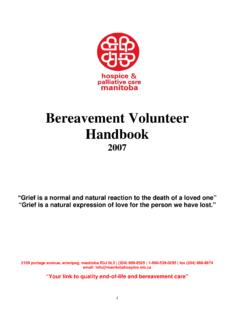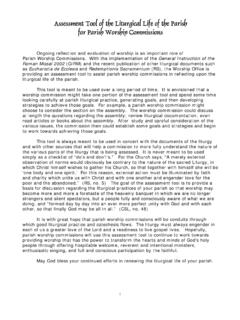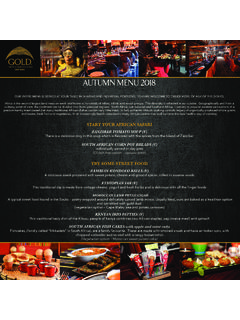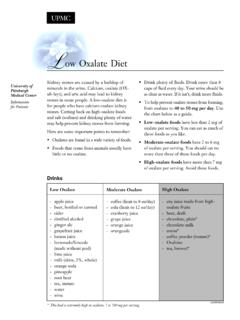Transcription of Cultural competence and Cross Cultural Care at the End of …
1 Cultural competence and Cross Cultural care at the End of Life By Loreen Feser MODULE OBJECTIVES: 1. Identify ways in which an individual s culture, ethnicity, and/or religion may influence his or her experience of terminal illness. 2. Identify beliefs and practices related to dying and death that are held by some individuals within various ethnic, Cultural and religious groups. 3. Identify strategies and resources for providing culturally competent care to terminally ill individuals and their families. Suggested Readings Cloutier, K., Customs and Traditions-in times of death and bereavement (2nd Ed) McInnis and Holloway Funeral Homes. Chardran, V., A Palliative Program in the East Indian Hindu Community. Palliative care Association of Alberta. Newsletter. Oct/Nov. 1998. Feser, L., Bon Bernard, C., Enhancing Cultural competence in Palliative care - Perspective of a Chinese Community in Calgary.
2 Journal of Palliative care (2003). Nueberger, J., Introduction - Cultural issues in Palliative care . Oxford Textbook of Palliative Medicine. 1998. Oxford University Press, Edited by Derek Doyle, Geoffrey Hanks and Neil MacDonald. p. 779- 785. Ying, Wang., Paice, Judith A., People's Republic of China. Textbook of Palliative Nursing. 2001. Oxford University Press, Edited by Ferrell, B and Coyle, N. P. 727-731. Lapine, A., Wang-Cheng R., Goldstein, M., Nooney, A., Lamb, G., and Derse, A. R., When Cultures Clash: Physician, Patient, and Family Wishes in Truth Disclosure for Dying Patients. Journal of Palliative Medicine. 4 (4) 2001: 475-480. Terminology Culture- Patterns of learned behaviours and values shared among members of a group that are transmitted over time. Included: ethnicity, language, religious and spiritual beliefs, gender, socio-economic class, age, sexual orientation, geographical origin, group history, education and upbringing and life experiences.
3 Diversity- a broad term reflecting unique characteristics of members of society or race, including colour, ethnicity, ancestry, place of origin age, gender, sexual orientation and physical and mental abilities and qualities. May also include socioeconomic status or class, education, language, marital status and religious beliefs. Ethnocultural group- A group of people who share common distinctive ethnicity, heritage culture, language, social patterns and sense of belonging. 12 1 Bon Bernard, C., Culturally Competent Professional Practice (2001) PLC Multicultural Awareness Program. 2 Visions: s Mental Health Journal, Winter 2000. Introduction Within the Canadian healthcare system, ensuring the equitable distribution of limited resources that can be accessed across the life span is increasingly more complex. This fundamental principle of access to services is identified by the Canadian Palliative care Association (CPCA) as the second of a number of principles of palliative The CPCA has indicated that patients and families should have timely access to the information and the services provided by palliative care .
4 Services and information should be provided when patients and families need and are prepared to accept palliative care . In addition, services and information should be provided in a language that the patient and family can understand. The concept of access implies not only linguistic and Cultural access but emotional preparedness as well. Beliefs about death, dying and emotional responses to terminal illness are influenced by culture. When, in the course of illness, individuals are prepared to accept palliative services may also be influenced by culture. As societal mobility and immigration increase so does the potential for increased Cultural and linguistic diversity. Palliative care clinicians are increasingly likely to care for patients with language, experiences, beliefs and culture different than their own. While palliative clinicians and providers can not be expected to have extensive knowledge of all immigrant groups and all diverse populations, it is prudent to have some idea of the values and beliefs of the groups that clinicians will come into contact with on a regular basis.
5 Having sufficient information to be able to identify trends or common beliefs and values within a population is useful. Palliative care providers however, must use Cultural information cautiously. To make assumptions about specific individuals based on their religious, ethnic or Cultural community alone would be stereotyping and may not accurately reflect the values of an individual or family. A broad range of beliefs might exist within a Cultural group. It is important that any Cultural knowledge be reviewed and validated with individual and family to determine its relevance for them. The goal of providing culturally competent care to diverse Cultural groups at the end of life is to be aware that a variety of beliefs, values, traditions, and practices exist and to honor these when providing care . Association with a particular Cultural , ethnic or religious group may influence: Expression and meaning of pain and suffering Attitude towards disclosure and awareness (of illness) Beliefs about the cause and meaning of illness Choice of healer and treatment regimen Attitude toward death and dying Beliefs about the afterlife, the value of human life, and the body Expressions of loss and grief Death rituals including preparation for burial, funeral practices or memorial services, customs for disposing of the body and mourning rites.
6 (From the Alberta Palliative care Resource, 1999) . The aforementioned are discussed within this module in terms of end of life care . In addition, ethical issues faced in Cross - Cultural care , strategies and resources are so discussed. 3 Canadian Palliative care Association. (1995). Palliative care : Towards a Consensus in Standardized Principles of Practice. P. 16-17. Cultural competence The need for Cultural competence is an increasingly integral part of professional practice in health care . The literature on culture increasingly critiques phrases such as Cultural sensitivity or multi-culturalism with recent literature moving to incorporating the notion of Cross - Cultural competence in health care . Cultural competence includes a set of values, behaviors, attitudes, knowledge and skills enabling providers to offer client care which is respectful and inclusive of diverse Cultural backgrounds.
7 Cross - Cultural competence starts with an attitude and genuine interest on behalf of the practitioner in experiencing, conversing about and participating in ongoing learning opportunities about diverse cultures. Cohen and Palos discuss the emic and etic perspectives of Cultural competence . The emic perspective looks for an understanding of how experiences are defined by natives or the persons within the culture, having the experience of life within the group. The etic perspective is the outsiders or researcher perspective involving observing a culture without learning how those being studied view the experience of the culture or the experience. In the etic perspective, external criteria is used to examine or compare groups or cultures. It is likely that in palliative situations, caregivers bring a combination of these perspectives however, we should always strive to understand from the insider view of the patient and family.
8 The concept of Cultural and linguistic competence extends beyond individuals to organizations and is defined as A set of congruent behaviors, attitudes, and policies that come together in a system, agency, or among professionals that enables effective work in Cross - Cultural situations. 4 Acknowledging the need for support of ethnic and Cultural diversity within health organizations led the Dept. of Health and Human Services to set standards for Cultural and linguistically appropriate Health care These include promoting and supporting attitudes, behaviors, knowledge and skills necessary for staff to work in a culturally competent manner as well as ongoing education and training for staff. The standards also include the ability of patients or clients to access qualified interpreters and to ensure the bilingual proficiency of translators. The collection of data for racial and ethnic groups within a service area also a requirement to insure good outcomes by identifying needs within a population, what resources are available and what gaps in service exist.
9 Discussion of the nuances of some of the complex issues at the end of life depends upon excellent communication between patient, family and caregivers. Linguistic access to palliative services may mean being able to access culturally appropriate pain or symptom assessment tools to communicate about symptoms. It may mean being able to access translated pamphlets about regional palliative services and resources. It may mean being able to access interpretation services which do not breech patient confidentiality, as may be the case if family, friends or hospital staff are asked to act as interpreters. Studies by McNamara (1997) which assessed the ability of palliative caregivers to deliver competent Cross - Cultural care found that language barriers, the availability and effective use of written translated materials and the appropriate use of interpreters were significant barriers. Conflicts between patients, families and palliative caregivers existed around beliefs and values about death, dying and bereavement.
10 Conflicts about revealing diagnosis (truth telling) or how and with whom information is shared within families was also found to be significant. 4 Cohen, M. Z., Palos, G., Seminars in Oncology Nursing. Vol. 17, ,(August) 2001:pp. 156 5 US Department of Health and Human Services: Assuring Culture competence in Health care : Recommendations for National Standards and an Outs-Focused Research Agenda It is important to be aware of your limits and Cultural competencies as a caregiver; to know how your own culture has influenced your beliefs and values prior to assessment of patients. The clinician should also be aware of basic rudiments the patient s culture including awareness of Cultural taboos. If the patient s preferred language is not the same as the clinicians, an interpreter should be arranged for, particularly when issues or significant information is being shared. If possible, unless there are extreme circumstances (such as a pain crisis or advanced directives are not known in an imminently life threatening situation) the interpreter should not be a member of the family.

















